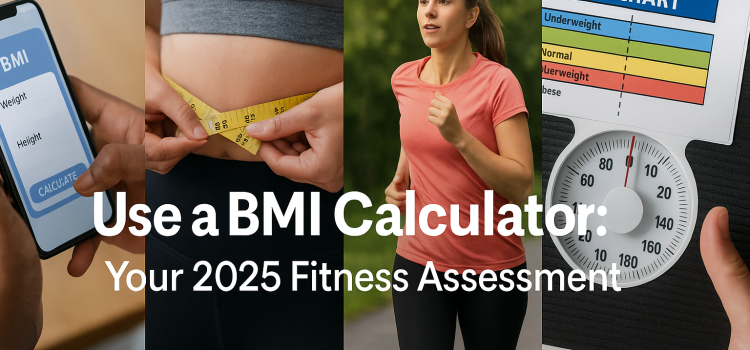
Introduction
Open any wellness app today and one figure still appears on the first screen: Body Mass Index, or BMI. Invented in the 1800s, BMI is a simple ratio of weight to height that sorts people into broad weight-status groups. In 2025, the metric sparks debate because it can misread muscle as fat or overlook fat distribution. Yet doctors, insurers, and public-health dashboards still rely on it for quick risk snapshots. The key is knowing what BMI can—and cannot—tell you. This guide walks you through modern BMI calculators, explains updated cutoffs, and shows how to combine BMI with smarter tools so you get a full, personalized view of fitness.
What Exactly Is BMI and Why Do We Still Use It?
Body Mass Index is calculated by dividing weight in kilograms by height in meters squared. The result is a single number. Health agencies keep it because it predicts disease odds in large groups faster than blood tests or scans. Clinics can screen thousands of patients in minutes, flagging who might benefit from deeper checks. For individuals, BMI offers a first-pass “red, yellow, or green” signal you can track over time. When used with context, it helps you spot trends—especially if a new job, medication, or life change causes rapid weight shifts.
How a 2025 BMI Calculator Works

Modern calculators ask for weight and height, just like older versions, but they add three upgrades:
- Unit Flexibility – You can switch among metric, U.S., and U.K. imperial systems without manual math.
- Age and Sex Input – Algorithms overlay demographic averages to fine-tune advice.
- Instant Trend Graphs – Many apps pull weight data from smart scales, plotting BMI over weeks for early-warning spikes.
In most apps:
- Enter weight—either type it or sync from a Bluetooth scale.
- Enter height once; the app stores it.
- Tap “calculate.” You’ll get a BMI figure plus a category label: underweight, healthy, overweight, or obesity grades I–III.
- View tips or connect to food-log and workout trackers for next steps.
Updated BMI Categories for 2025
| Category | BMI Range | General Health Note |
|---|---|---|
| Underweight | below 18.5 | May signal nutrient gaps or hormonal issues |
| Healthy Weight | 18.5–24.9 | Lowest average risk for metabolic disease |
| Overweight | 25.0–29.9 | Moderate risk; lifestyle tweaks advised |
| Obesity Grade I | 30.0–34.9 | Elevated cardiovascular and joint stress |
| Obesity Grade II | 35.0–39.9 | High risk; medical screening recommended |
| Obesity Grade III | 40 and above | Very high risk; specialist care often needed |
Experts considered lowering cutoffs for certain Asian populations, but in 2025 most global guidelines still use the ranges above while encouraging ethnicity-specific context.
Limits of BMI You Should Know
BMI looks only at total mass, ignoring muscle versus fat. A lean bodybuilder and a sedentary office worker can both post a BMI of 28, though their health profiles differ. BMI also says nothing about where fat settles. Visceral fat around organs drives higher disease risk than subcutaneous fat under the skin, yet both weigh the same on a scale. Age matters, too: older adults naturally lose muscle, so their BMI can stay “normal” while fat creeps up invisibly. Recognizing these gaps prevents false reassurance or unnecessary panic.
Complementary Metrics for a Smarter Picture

Waist Circumference
Wrap a tape measure at navel height after exhaling. Numbers above 35 inches for women or 40 inches for men often signal unhealthy abdominal fat.
Waist-to-Height Ratio
Divide waist size by height. A ratio above 0.5 suggests excess central fat even if BMI looks fine.
Body Fat Percentage
Smart scales or DEXA scans estimate fat versus lean tissue. Targets vary by sex and age but generally fall between 18–28 percent for adult women and 10–20 percent for adult men.
Visceral Fat Score
High-end scales assign a score from 0–30. Staying under 12 reduces risk for diabetes and heart disease.
Using at least one of these alongside BMI turns a single datapoint into a multilayered health dashboard.
Choosing the Right BMI Calculator App in 2025
When picking an app, look for these features:
- Device Sync – Does it pair with your scale or fitness band?
- Actionable Insights – Apps that translate numbers into daily goals keep you motivated.
- Customization – Athletes may need separate muscle-mass notes; older adults need sarcopenia screening.
- Data Privacy – Confirm end-to-end encryption; health data is valuable.
- Integration – Can you export reports to your doctor or insurance portal?
Popular apps like FitMeter 2025, HealthLoop, and BodyIQ tick most boxes while offering free trials.
Tips to Improve or Maintain a Healthy BMI
- Track Consistently – Weigh in at the same time of day, ideally morning after bathroom visits, to reduce water-weight noise.
- Aim for Small Changes – A half-pound shift per week beats crash dieting and sticks better long term.
- Prioritize Protein and Fiber – These nutrients boost satiety, helping control total calories without strict counting.
- Move More in Micro-Bursts – Five mini-workouts of five minutes can match one long session in calorie burn and be easier to fit into busy schedules.
- Sleep Seven Hours – Poor sleep raises hunger hormones, making weight management harder.
- Manage Stress – Chronic cortisol spikes drive belly-fat storage. Mindfulness apps, walks, or hobbies cut that loop.
Trends in Personalized Fitness Assessment

Artificial-intelligence engines now merge BMI with smartwatch heart-rate variability, food scans, and menstrual-cycle data to predict weight shifts weeks ahead. Some gyms offer 3D body scans that map shape changes even when the scale plateaus, motivating members beyond numbers. Insurance firms increasingly use opt-in health dashboards to offer premium discounts for steady healthy-range BMI plus active-minutes streaks. Meanwhile, public-health dashboards anonymize aggregate BMI data by zip code, guiding city planners to place bike lanes where obesity clusters persist.
Conclusion
BMI remains a quick, useful snapshot for large-scale health screening and personal goal-setting. Yet the smartest 2025 approach is to treat the number as a starting point, then layer waist measures, body-fat estimates, and lifestyle data for richer insight. Pair a trustworthy BMI calculator app with consistent tracking, balanced nutrition, and regular movement, and you turn a simple ratio into a powerful driver of long-term fitness.
Call to Action
Download a reliable BMI calculator today, enter your stats, and record the number. Then add a waist measure and one lifestyle change this week—maybe a daily ten-minute walk. Track progress for a month, and see how small, steady steps reshape your health trajectory.










